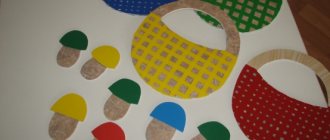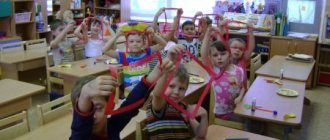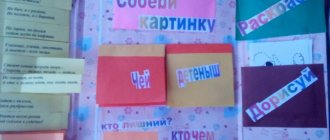Teaching numeracy, systematized and methodologically justified by the Federal State Educational Standard (FSES), is included in the system of work with preschoolers in kindergarten. However, the age characteristics of children require particularly careful preparation of visual aids. The most important role is given to the counting material. We will look at the types of counting material used in mathematics classes in different age groups, and give advice on how to make it yourself as a demonstration and handout.
- 2 Features of demonstration and handout material for different age groups
2.1 Types of handouts2.1.1 Photo gallery: examples of counting handouts
- 3.1 How to make didactic materials for the preparatory group with your own hands
3.1.1 Photo gallery: example of a homemade laptop
- 4.1 Photo gallery: examples of individual cards and a picture for a mobile folder
- 5.1 Photo gallery: individual cards for the senior group
The validity of using visual counting material in kindergarten
In a preschool educational institution, children begin to master counting at the age of three, and this is their main mathematical activity. Learning takes place with the indispensable support of visual aids, since abstract logical operations performed during counting (merging and dividing sets, comparing quantities and numbers, comparing sets) are difficult for children to understand and require “objectification.” Visual counting material is a comprehensive didactic tool aimed at developing basic ideas about counting as part of targeted learning.
Famous teacher K.D. Ushinsky said: “Children’s nature itself requires visual learning.”
Such benefits are very diverse, and their application in each case depends on:
- specific content of educational material (for example, teach children of the second youngest group to distinguish between the concepts of many and few);
- methods used (more precisely, certain gaming techniques, for example, illustrations for a fairy tale in which characters learn to count);
- the age of the children (if in the second younger group there may be cards with pictures of the same animal, then in the older group the pictures depict different animals, that is, the essence of the phenomenon being described becomes more complex).
Counting in kindergarten is mastered along with other didactic skills and concepts, for example, learning about colors: distribute the mushrooms into baskets of the corresponding colors and say which one has more/fewer of them
Visual material must meet the following requirements:
- scientific (correspond to scientific data on counting);
- pedagogical (carry an educational, developmental, educational load);
- sanitary and hygienic (do not contain harmful substances, do not cause eye strain;
- aesthetic (beautiful design, bright and clear images)
Features of demonstration and handout material for different age groups
Calculating material in mathematics, like other visual aids, can be of two types:
- large, that is, demonstration, which is used by the teacher to explain and show how to operate with it (magnetic boards, posters, paintings, etc.);
- small, that is, handout (cards, laptops, etc.), using which all children perform certain tasks at the same time, which allows organizing independent activities of children to develop the necessary mathematical skills and abilities.
Visual mathematical material differs in the type of counting activity, which is a priority for a specific age category.
- Second junior group. To form the concept of singularity and multiplicity, you can use, for example, puzzle pictures, cubes in which numbers are surrounded by elements with the same number of fruits (vegetables, animals, etc.) or pictures with dots that need to be correlated with the number. By the way, the same material with dots is still used, only there are more numbers.
- Middle group. Children must be able to give an accurate assessment of a set of objects, in this case counting to 5. For this, pictures depicting objects and numbers corresponding to their quantity are actively used, as well as a combination of a toy and a three-dimensional number. For example, to recognize the graphic image of a number, the task could be as follows: help the bunny find the number 3. Place a moth on a flower with five petals.
- Senior group. Kids count to 10 and can add or subtract one at a time. For clarity, they use, for example, the game of dominoes, matching a number with a picture with the same number of objects.
- Preparatory group. Children can compare numbers “more and less”, and make up given numbers from two smaller ones - 5 from 2 and 3, for example. The demonstration material becomes more complex. These could be tasks for comparing the number of objects in pictures, composing a whole image after sequentially folding numbered cut parts, etc.
Counting sticks are a universal visual aid: they allow you to demonstrate and practice all types of counting activities.
Thus, the first manuals are aimed at ensuring that children learn to correlate the visual image of a number and the number of objects it denotes. In the middle group, this work is no longer on “recognizing” the image of a number, but on quantitative counting up to 5. In the older group, children learn to perform basic addition and subtraction operations, and in the preparatory task materials are comparative in nature, since children already know how to correlate quantities , indicated by numbers.
At any stage of training, it is necessary to think over a way to get acquainted with the graphic image of a number, for example, in the form of creating an application
Types of handouts
As already mentioned, manuals can be demonstration or handout. And there are also those that can be used in both cases (for example, Dienesh blocks). The teacher chooses the types of handouts depending on the age of the children. So, already in the first junior group, children get acquainted with cubes and counting sticks. True, so far the assessment level is “a lot or a little.” Typically, the gradation of the use of types of handouts depends on the age of the children: the younger, the more toys, and the older, the more drawings and diagrams. In general, the following counting aids are actively used in kindergarten:
- Cuisenaire sticks (multi-colored parallelepipeds of different sizes made of wood or plastic are used mainly in the second junior and middle groups, when the concept of quantity is introduced);
- Dienesh blocks (a set of geometric shapes of different sizes, which can be used by analogy with Cuisenaire sticks, as well as to introduce rectangles, triangles, circles, squares);
- cubes (in the younger group they practice the concepts of “many and few”);
- pyramids (as a budget, more affordable version of Cuisenaire sticks and Dienesh blocks);
- beads, buttons (in junior and middle groups);
- pictures, puzzle pictures, cards (for all ages);
- fan with numbers (for senior and preparatory groups, in which the children already clearly associate a number with its graphic image);
- lapbooks, tasks in which can combine all of the above manuals, etc.
Please note that there is no clear age division in the use of counting materials, since their use must be justified from the point of view of the educational goal. And yet, in the senior and preparatory groups, the emphasis is on cards, so that children get used to working with clarity “like at school.”
Photo gallery: examples of counting handouts
The capabilities of counting cubes allow them to be used up to the preparatory group
To master the skill of counting to 5, it is convenient to use special pyramids
A fan with numbers is a tool for school, but can also be used in kindergarten
Using blocks you can practice mastering basic geometric shapes and counting objects in groups
You can learn to count on sticks completely unnoticed: for example, by laying out figures from them
A visual aid for the book corner of the second junior group.
A visual aid for the book corner in the second junior group.
The book introduces a child to the most difficult things in life - into the world of human feelings, joys and sufferings, relationships, motives, thoughts, actions, characters. The book teaches you to look into a person, see and understand him, and cultivates humanity. Read in childhood, it leaves a stronger impression than read in adulthood. The corner of a book plays a significant role in developing preschoolers’ interest in fiction. This is a special, specially designated place where a child can independently, according to his taste, choose a book and calmly examine and “re-read” it. Here there is an intimate, personal communication between a child and a work of art - a book and illustrations. All kindergarten groups should have a book corner. The main principle that teachers must adhere to when organizing it is to satisfy the diverse literary interests of children. Each teacher can show individual taste and creativity in decorating a corner of a book. The book corner should be cozy, attractive, inviting the child to leisurely, focused communication with the book. The selection of literature and pedagogical work organized in the book corner must correspond to the age characteristics and needs of children.
In younger groups,
the teacher gives children the first lessons in independent communication with a book: introduces them to the corner of the book, its structure and purpose, teaches them to look at books and pictures only there, tells the rules that must be followed (take books with clean hands, leaf through carefully, do not tear, do not wrinkle, do not use for games; after looking, always put the book back).
Later, in the middle group
, the basic skills of independently and carefully looking at books are consolidated and become a habit.
As a rule, a few
(4-5) books
in the book showcase of the younger group . However, the teacher should have additional copies of the same books nearby. The replacement period for books is 2 – 2.5 weeks. As a rule, publications already familiar to children with bright, large illustrations are placed in the corner of the book; in addition to books, there may be individual pictures pasted on thick paper. There should also be small albums for viewing (topics: “Toys”, “Games and activities”, “Pets”, etc.). Books should have a small amount of text, with large colorful illustrations - picture books: fairy tales “Kolobok”, “Turnip”; “Toys” by A. Barto, “Fire Horse” by V. Mayakovsky, “Mustachioed and Striped” by S. Marshak, etc.
In order to more easily explain the rules for using the book in the second junior group, I have developed a visual aid that allows each rule to be visualized, which makes learning the rules more interesting and memorable. While voicing each rule, I simultaneously show the corresponding picture.
- Take the book with clean hands:
- Flip carefully past the corner of the page:
- Do not tear, do not crush, do not use for games:
- Do not throw:
- Always put the book in its place:
We remember that books are our friends! It depends only on the adult how the child will handle the book. Take care of the book!
Used materials:
Material from the site: https://nsportal.ru/detskii-sad/raznoe/proekt-ugolok-knigi-v-detskom-sadu
Gurovich L.M., Beregovaya L.B., Loginova V.I. Child and book. – M.: Education, 1992.
Teacher of MBDOU No. 308
Krasnoyarsk
A.Yu.Rudakova
Lapbook for FEMP “Quantity and counting”
A laptop is a folder that contains material on a specific topic. The organization of the material in such a manual is that the teacher arranges the visualization in the form of mini-books, accordion layouts, gift boxes, windows or pockets, etc. In addition, the lapbook necessarily includes tasks of a creative nature.
Lapbooks are also used to form elementary mathematical concepts (EMPs) - the fruits of the teacher’s creative approach to the implementation of learning tasks. Benefits are calculated for a specific stage of training. Since lapbooks were originally made by parents to teach their child, these manuals, put on a “methodological stream,” are now used for individual work, as well as for working in pairs or threes.
How to make didactic materials for a preparatory group with your own hands
First, you need to determine the goals of the Quantity and Counting lapbook.
- Strengthen the ability to count to 10.
- Practice ordinal and quantitative counting.
- Practice the skill of comparing numbers with the number of objects.
- Learn to write numbers.
- Develop the ability to add, subtract and compare numbers within 10.
- Develop active vocabulary, logic, memory and thinking.
- Work on the ability to independently solve assigned problems.
- Cultivate responsiveness, self-confidence and self-confidence.
After the organizational stage, you can proceed directly to production. This process begins with the preparation of the necessary materials. Moreover, methodological questions are developed first, and only then a suitable design is selected for them.
Typically a lapbook includes:
- pictures with numbers for visual perception of their graphic image;
- cards with numbers and objects (either separately or 2 in 1);
- puzzles (cut numbers or pictures, each piece of which shows a number, etc.);
- pictures of fairy tales with numbers in their titles;
- coloring books;
- copybook;
- riddles, counting rhymes, etc.
It is most convenient to organize materials into files, which, in turn, are stored in a folder. The cover of this manual frame should also be brightly designed. But with such packaging, it is troublesome to work with the materials: before use, part of the manual will have to be laid out. So you can take advantage of the experience of your colleagues and make the pages of the lapbook cardboard, and on these sheets you can attach files, pop-up books, and boxes with surprises.
Photo gallery: example of a homemade laptop
For a lapbook, using a binder is the most durable
Cards with dots and numbers can be placed in bright envelopes so that the baby becomes interested in their contents
When producing such a manual, it is assumed that children know how to write
By laying out numbers from elements, children remember the graphic image of numbers and also train their eye
With the help of a lapbook, children quickly and easily understand the essence of comparison
Having solved the example on the garage and on the car, the child must correlate the same answers
Children, as a rule, get excited about playing dominoes.
Individual cards in mathematics for the second junior, middle, senior groups
Learning to count is something that requires maximum concentration and constant practice from a child. The latter is designed to provide individual cards - methodological aids for working on a topic one at a time or in mini-groups (2-3 people).
- In the second younger group, to practice the concept of one-many, for example, a card may have a picture of a steam locomotive. The child receives a stack of trailers and distributes them according to the card. At the same time, the adult focuses the child’s attention on the fact that at first there were no carriages, then one appeared, and then “many.”
- In the middle group, counting to 5 is very effectively trained by correlating elements of pictures (for example, dots on the back of a ladybug) and a graphic image of the number.
- In the older group, to practice counting to 10, you can use tables with dots and small cards with numbers that children must correlate with each other. Or cards with numbers to restore counting order. By the way, the skill of writing numbers is trained in the same way.
- In the preparatory group, the cards can be graphic examples of addition and subtraction: the child counts the number of objects to the left of the + or - sign and writes the result in the cell provided for this.
For practical reasons, it is better to laminate cards. Then, even if the child needs to write something on an assignment (for example, the answer to the solution to an example), he will be able to do it with a marker that can be easily wiped off the cellophane.
To ensure that the numbers are always in the children’s field of view, you can install a “Fun Counting” folder in the group. She will introduce the kids to both numbers and the number of objects in a group.
Photo gallery: examples of individual cards and a picture for a mobile folder
In the younger group, kids learn to evaluate sets by attaching different numbers of cars to locomotives
In the preparatory group, children perform addition and subtraction in the range from 1 to 10
A child in the middle group must count the spots on the back of a ladybug and connect it with the appropriate number.
In the older group, children learn to perform simple arithmetic operations ranging from 1 to 10
Bright and beautiful pictures from the mobile folder will attract the attention of the children and teach them to correlate the number with the number of objects
Junior group. Early childhood, nursery. Children 1-4 years old
Abstract of an OD on cognitive development “To the doctor at the hospital” using the “Hospital” layout for children 2–3 years old Objectives: Educational: teach to take on a gaming role (doctor’s assistant, patient, encourage children to play out the plot of the familiar game “Hospital”
using familiar medical instruments
(toy ones)
and
hospital
layout .
Developmental: to promote the emergence of role-playing...
Master class on making a mini-model for the nursery rhyme “The cat went to Torzhok” (second group of early age)
Nursery rhymes are a small genre of oral folk art. Nursery rhymes are always funny and laconic. They perfectly develop a child’s speech hearing. Despite the fact that nursery rhymes are called small folklore forms, they play a big role in the development and upbringing of a child. Brevity and small...
Pictures for teaching counting in senior and preparatory groups
There are no particular differences in the form of the pictures, only the tasks, that is, the content, differ.
Photo gallery: individual cards for the senior group
Number cards can be made at home
By rearranging the number of balls, the child will learn to count to 10, as well as sort things according to the “new/old” principle.
An individual card may contain a creative task: sculpt a number from plasticine
Such houses help children learn the composition of numbers
It is worth noting that the cards do not always represent a drawn/pasted image. An individual card may consist of individual elements that are laid out on a sheet. A kind of overlay applique.
Photo gallery: counting aids for the preparatory group
This is how children are presented with the principle of variability of terms with the same amount
This is a dynamic card, that is, it comes with a pocket with balls with examples, as well as cards with answer numbers
In the preparatory group, children easily cope with the task of writing down the neighbors of the numbers in the windows of the house
This guide not only trains math skills, but also develops fine motor skills.
Demonstration counting material is a manifestation of the teacher’s imagination, aimed at ensuring that children learn the basics of mathematical operations while playing. Lapbooks have proven themselves very well, as the children enjoy playing with such large applications, which include pictures, puzzles, and coloring books. When preparing this manual, two important points must be taken into account: the laptop must be strong, that is, not crumble during use, and entertaining, so that with its help the teacher can realize the set training, developmental and educational goals.
Preparatory group. Senior preschool age. Children 6-7 years old
Layout according to traffic regulations “Safe Road” for children of the senior and preparatory groups This layout is presented for children of the senior and preparatory groups. It is mobile: all road signs are glued with Velcro, thereby you can easily change conditions and create problematic situations for children . this manual , they use it for plot...
Photo report on the production of the model “Fantasy Day. Planet of Champions" in the preparatory group
October 18 is Science Fiction Day at MAAM (on the birthday of Kira Bulychev. Kira Bulychev is an author whose works fascinate with their uniqueness. Are modern children familiar with this science fiction writer? Have parents read Kira Bulychev’s books to their children (he had many pseudonyms?...








